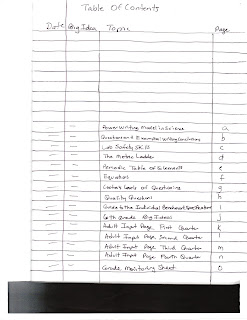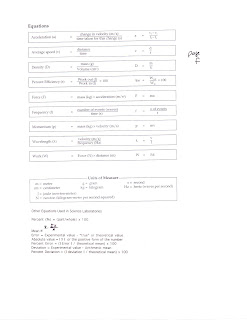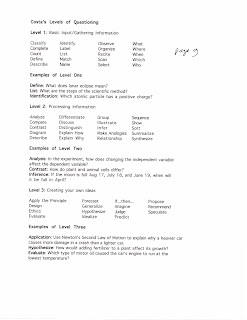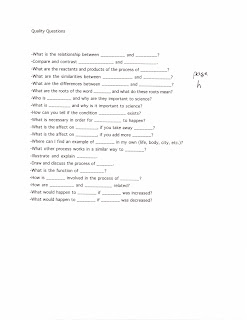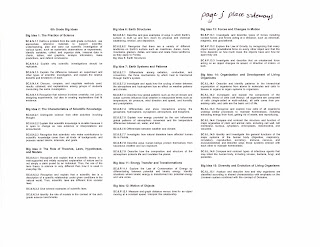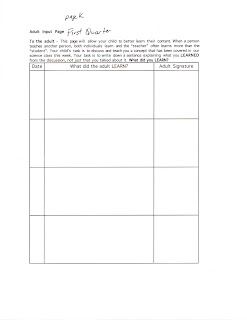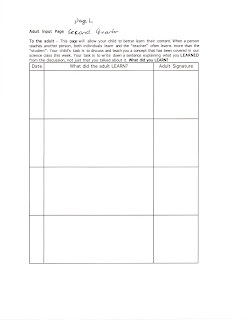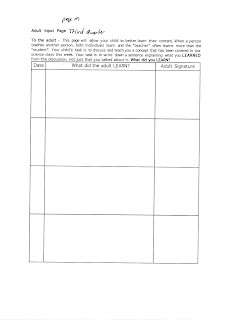Students will be able to:
use information from laboratory activities and classroom discussions to
-measure temperature as a model greenhouse and a control are heated.
-determine the temperature changes for the two containers.
-use the results to make conclusions about the greenhouse effect.
Students completed the lab (check yesterday's lab and blog), and answered all questions. Students then used page b to write the lab up.
The home work is to answer all questions on the problem set sheet.
Thursday, September 30, 2010
Tuesday, September 28, 2010
Tuesday, 28 September and Wednesday, 29 September, 2010
Students will be able to:
use information from laboratory activities and classroom discussions to
-measure temperature as a model greenhouse and a control are heated.
-determine the temperature changes for the two containers.
-use the results to make conclusions about the greenhouse effect.
After collecting home learning, students performed the greenhouse effect laboratory. They also used power writing to write up the lab in their interactive notebooks.
Home learning was to update the notebook.
For students who were absent for the lab, visit the Dr. Gayden's Science Zone for Sixth Graders (drgcdms6.podomatic.com) and do the activity listed. Be sure to write out:
Title of Lab
Problem
Hypothesis: If/then statement
Variables: independent, dependent, constant, control
Data and Observations
Conclusions and Analysis by answering questions 1-7 found on page B of your interactive notebook.
use information from laboratory activities and classroom discussions to
-measure temperature as a model greenhouse and a control are heated.
-determine the temperature changes for the two containers.
-use the results to make conclusions about the greenhouse effect.
After collecting home learning, students performed the greenhouse effect laboratory. They also used power writing to write up the lab in their interactive notebooks.
Home learning was to update the notebook.
For students who were absent for the lab, visit the Dr. Gayden's Science Zone for Sixth Graders (drgcdms6.podomatic.com) and do the activity listed. Be sure to write out:
Title of Lab
Problem
Hypothesis: If/then statement
Variables: independent, dependent, constant, control
Data and Observations
Conclusions and Analysis by answering questions 1-7 found on page B of your interactive notebook.
Monday, September 27, 2010
Monday, 23 September, 2010
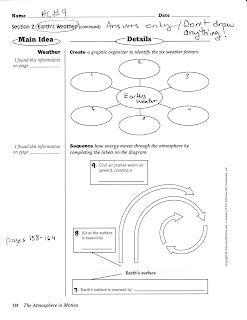
This is HL #9.
Students will be able to:
use information from virtual laboratories and classroom discussions to
-describe the structure of earth's atmosphere.
-investigate temperature, density, and pressure changes in layers of Earth's atmosphere.
-identify meteorological and astronomical phenomena that occur in layers of Earth's atmosphere.
Students reviewed home learning 8 and received home learning 9.
Once finished, each student completed the atmosphere activity.
Friday, September 24, 2010
Friday, 24 September, 2010
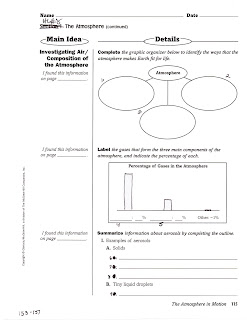
This is HL #8. On your own loose leaf notebook paper, in blue/black ink or pencil, headed correctly in the UPPER RIGHT HAND CORNER, with four lines (last name, first name; date; Period; HL #8), and with the title (The Atmosphere) on the first line: answers only for the nine questions. Be sure to include the name AND percentage for questions 4 and 5.Use pages 153-157 in your text to answer the questions.

This is the do now sheet. SInce we did not complete in class, please bring to class on Monday for completion.
Students will be able to:
use information from baseine examination and classroom discussions to
-debrief he exam.
Students completed the debriefing of the District baseline examination.
Students took a quiz on the layers of the atmosphere.
Students were also issued a worksheet on the layers of the atmosphere, which we did not get a chance to complete. It will be completed next class period. That, and home learning 8, are posted at the top of this blog.
Thursday, September 23, 2010
Thursday, 23 September, 2010
Students will be able to:
use information from the baseline and classroom discussions to
-debrief the exam.
Today was early release. Students reviewed the baseline examination.
use information from the baseline and classroom discussions to
-debrief the exam.
Today was early release. Students reviewed the baseline examination.
Wednesday, September 22, 2010
Wednesday, 22 September, 2010


Students will be able to:
use information from virtual laboratories and classroom discussions to
-describe the structure of earth's atmosphere.
-investigate temperature, density, and pressure changes in layers of Earth's atmosphere.
-identify meteorological and astronomical phenomena that occur in layers of Earth's atmosphere.
Students spent the class period completing a virtual lab on the atmospheric layers. You can find the handouts at the top of this blog. You can do the activity by either cutting and pasting the link below or going to Dr. Gayden's Science Zone for Tuesday, 21 September, and clicking the link for the 6th grade.
http://www.glencoe.com/sites/common_assets/science/virtual_labs/ES14/ES14.html
Tuesday, September 21, 2010
Tuesday, 21 September, 2010


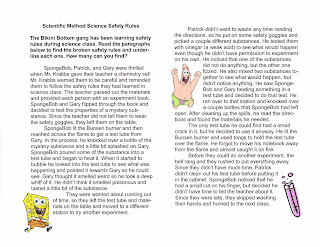
Students will be able to:
use information from textbooks, supplementary texts, and classroom discussions to
-describe the structure of earth's atmosphere.
-investigate temperature, density, and pressure changes in layers of Earth's atmosphere.
-identify meteorological and astronomical phenomena that occur in layers of Earth's atmosphere.
-review lab safety.
Students first reviewed the lab safety from page C in their interactive notebooks. They were then given a sheet to identify unsafe laboratory procedures. You can find this sheet at the top of this blog.
Students received a safety contract. This is to be signed by student and parent. This is HL #7. It should be brought back tomorrow.
Students spent the remainder of the class preparing the visuals assigned by group for the layers of the atmosphere.
Interactive notebooks were collected.
Monday, September 20, 2010
Monday, 20 September, 2010
Students will be able to:
use information from videos from the internet, supplementary texts, and classroom discussions to
-model the layers of the atmosphere.
-compare and contrast the different layers of the atmosphere.
-describe how the composition and structure of the atmosphere protects life and insulates the planet.
The do now was to calculate the thickness of each layer of the atmosphere:
Troposphere begins at ground level, extends up 10 km:
Stratosphere, from troposphere to 50 km;
Mesosphere, extends from stratosphere to 80 km;
Thermosphere, from mesosphere to 700 km;
Exosphere from thermosphere to 800 km
Students reviewed home learning 6.
Students reviewed what is necessary for notebook check 1. Students should have ALL pages pasted in, which includes inside front and back cover, pages 1, 5-10 and a-o. They should have table of contents completed, and paste in the last page of the table of contents. All notes should be done, including the three questions, the highlighted answers, and the summary at the bottom of the page. All home learnings should be pasted in. FInally, they should teach one of the concepts to an adult, and have the adult write what they learned on page K of the notebook, and sign in the appropriate place.
Students watched a BrainPop on the Earth's Atmosphere.
Students then worked in their groups to find information for each layer of the atmosphere.
The home learning is to get the notebook ready.
Since I have not posted pages a-o before, please look under Saturday, 18 September, 2010 to find all pages a-o.
use information from videos from the internet, supplementary texts, and classroom discussions to
-model the layers of the atmosphere.
-compare and contrast the different layers of the atmosphere.
-describe how the composition and structure of the atmosphere protects life and insulates the planet.
The do now was to calculate the thickness of each layer of the atmosphere:
Troposphere begins at ground level, extends up 10 km:
Stratosphere, from troposphere to 50 km;
Mesosphere, extends from stratosphere to 80 km;
Thermosphere, from mesosphere to 700 km;
Exosphere from thermosphere to 800 km
Students reviewed home learning 6.
Students reviewed what is necessary for notebook check 1. Students should have ALL pages pasted in, which includes inside front and back cover, pages 1, 5-10 and a-o. They should have table of contents completed, and paste in the last page of the table of contents. All notes should be done, including the three questions, the highlighted answers, and the summary at the bottom of the page. All home learnings should be pasted in. FInally, they should teach one of the concepts to an adult, and have the adult write what they learned on page K of the notebook, and sign in the appropriate place.
Students watched a BrainPop on the Earth's Atmosphere.
Students then worked in their groups to find information for each layer of the atmosphere.
The home learning is to get the notebook ready.
Since I have not posted pages a-o before, please look under Saturday, 18 September, 2010 to find all pages a-o.
Saturday, September 18, 2010
Friday, September 17, 2010
Friday, 17 September, 2010

This is HL #6. Be sure to head your loose leaf paper correctly! Answers only!
Students will be able to:
use information from the internet, supplementary texts, and classroom discussions to
-observe and infer relationships between UV light and radiation.
-analyze the effect of UV light and radiation on humans.
-describe the ways human beings protect themselves from hazardous weather and conditions.
-evaluate the effects of the loss of ozone on the environments of the earth.
Students received an electromagnetic spectrum chart. They were told to identify the type of electromagnetic wave, along with its frequency and wavelength, that causes sunburn.
Science fair plans were collected and will be returned on Monday.
Students then went to DrGCDMS6.podomatic.com to find the online activity that corresponds with this lesson. They were told to save the earth by reducing the amount of greenhouse gases found in the atmosphere.
Students recorded any new and important information as they learned about reduction of gases.
Students will do home learning 6 as their nightly home learning stop. You can find the handout at the top of this blog. Be sure to write on loose leaf paper, follow all written directions, and write only the answers.
Thursday, September 16, 2010
Thursday, 16 September, 2209
Students will be able to:
use information from videos from the internet, supplementary texts, and classroom discussions to
-observe and infer relationships between UV light and radiation.
-analyze the effect of UV light and radiation on humans.
-describe the ways human beings protect themselves from hazardous weather and conditions.
-evaluate the effects of the loss of ozone on the environments of the earth.
The do now was a quick write: What is ozone/ How does it relate to the greenhouse effect?
All students took notes about the ozone and greenhouse effects.
The ozone layer forms a thin shield high up in the sky. It protects life on Earth from the sun's ultraviolet (UV).
Recently, chlorofluorocarbons (CFCs) were used a lot in industry and elsewhere to keep things cold and to make foam and soaps. Strong winds carry CFCs up into the stratosphere where UV radiation breaks them apart, releasing chlorine atoms. Each chlorine atom can attack and break apart (destroy) as many as 100,000 ozone molecules during the time it is in the stratosphere. The chlorine from CFCs reduces (depletes) the amount of ozone in the stratosphere.
Other ozone-eating chemicals are pesticides such as methyl bromide, halons used in fire extinguishers, and methyl chloroform used in businesses.
Students are to update their notebooks, and be sure to complete the science fair plan.
use information from videos from the internet, supplementary texts, and classroom discussions to
-observe and infer relationships between UV light and radiation.
-analyze the effect of UV light and radiation on humans.
-describe the ways human beings protect themselves from hazardous weather and conditions.
-evaluate the effects of the loss of ozone on the environments of the earth.
The do now was a quick write: What is ozone/ How does it relate to the greenhouse effect?
All students took notes about the ozone and greenhouse effects.
The ozone layer forms a thin shield high up in the sky. It protects life on Earth from the sun's ultraviolet (UV).
Recently, chlorofluorocarbons (CFCs) were used a lot in industry and elsewhere to keep things cold and to make foam and soaps. Strong winds carry CFCs up into the stratosphere where UV radiation breaks them apart, releasing chlorine atoms. Each chlorine atom can attack and break apart (destroy) as many as 100,000 ozone molecules during the time it is in the stratosphere. The chlorine from CFCs reduces (depletes) the amount of ozone in the stratosphere.
Other ozone-eating chemicals are pesticides such as methyl bromide, halons used in fire extinguishers, and methyl chloroform used in businesses.
Students are to update their notebooks, and be sure to complete the science fair plan.
Tuesday, 14 September and Wednesday, 15 September, 2010
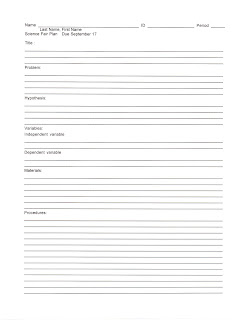

These are the science fair planning sheets. Please write legibly.
Students will be able to:
use information from lectures and the internet to
-understand how to research a problem.
-write a reference using the ALA or MLA styles.
-write a science fair plan.
Students were in the media center learning about the difference between plagearism, quoteing, and paraphrasing. They also learned how to cite references. All this preparation is to get ready for the Science Fair project. Science fair plans are due Friday.
Students watched a BrainPop movie on Wednesday on Citing Sources to identify how to write their references.
Monday, September 13, 2010
Monday, 13 September, 2010
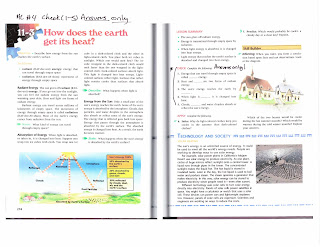
This is HL #4
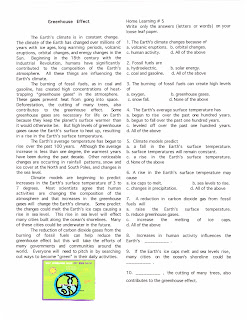
This is HL #5
Students will be able to:
use information from videos from the internet, supplementary texts, and classroom discussions to
-observe and infer relationships between UV light and radiation.
-analyze the effect of UV light and radiation on humans.
-describe the ways human beings protect themselves from hazardous weather and conditions.
-evaluate the effects of the loss of ozone on the environments of the earth.
The do now was a quick write: Have you every had a sunburn? How did you get it? How did it feel? If you haven't why not?
Students first completed the Mexican Jumping Bean activity on heat transfer by writing their conclusions and analysis.
They then received home learnings 4 and 5, which can be found at the top of this blog. They should be done on separate sheets of loose leaf notebook paper.
Students discussed the effects of global warming, brought about by the effects of global warming due to the Greenhouse Effect by looking at a picture of a glacial break four times the size of Manhattan island in NY.
Students watched a BrainPop movie on the ozone layer and discussed the content.
Students also received the remainder of the pages for the interactive notebook. Because the pages are so numerous, they will be posted on a separate day (Saturday, 11 September, 2010). If you loose them, you can check that date to print out new ones. I will stay after school this Thursday to help anyone needing help assembling their notebook.
Saturday, September 11, 2010
Friday, 10 September, 2010
Students will be able to:
use information from hands on activities and classroom discussions to
-design an experiment to test heat transfer from one object to another.
Students did an individual investigation using Mexican Jumping Beans. Students made sure to answer the following for the investigation:
-Question: What do you want to find out?
-Hypothesis: What do you think will happen?
-Procedure: Design your experiment. Write the steps for your experiment in the space below.
-Safety Rules: What safety rules do you need to follow during your experiment?
-Data: Create a table, chart, or graph to record your data.
-Conclusions/Analysis: What did you find out? Did your results support your hypothesis? Are your results reliable?
Students must draw a representative of the activity done in class. They should then complete the notes by writing what they learned.
use information from hands on activities and classroom discussions to
-design an experiment to test heat transfer from one object to another.
Students did an individual investigation using Mexican Jumping Beans. Students made sure to answer the following for the investigation:
-Question: What do you want to find out?
-Hypothesis: What do you think will happen?
-Procedure: Design your experiment. Write the steps for your experiment in the space below.
-Safety Rules: What safety rules do you need to follow during your experiment?
-Data: Create a table, chart, or graph to record your data.
-Conclusions/Analysis: What did you find out? Did your results support your hypothesis? Are your results reliable?
Students must draw a representative of the activity done in class. They should then complete the notes by writing what they learned.
Tuesday, September 7, 2010
Tuesday, 7 September and Wednesday, 8 September, 2010
Students will be able to:
use prior knowledge to
-take a baseline assessment in science.
Due to a mistake on my part, the 7th graders short story information was incorrect. As a result, they were given an additional day to work on their stories. The same courtesy is extended to you. Your stories are due tomorrow, with no penalty. However, be sure to adhere to the rubrics you received.
Students took the first half of the baseline assessment today and will complete the exam tomorrow.
Students will submit short stories tomorrow.
For home learning, design an experiment that would test the observation that an object tends to move more when its warm.
use prior knowledge to
-take a baseline assessment in science.
Due to a mistake on my part, the 7th graders short story information was incorrect. As a result, they were given an additional day to work on their stories. The same courtesy is extended to you. Your stories are due tomorrow, with no penalty. However, be sure to adhere to the rubrics you received.
Students took the first half of the baseline assessment today and will complete the exam tomorrow.
Students will submit short stories tomorrow.
For home learning, design an experiment that would test the observation that an object tends to move more when its warm.
Friday, September 3, 2010
Friday, 3 September, 2010
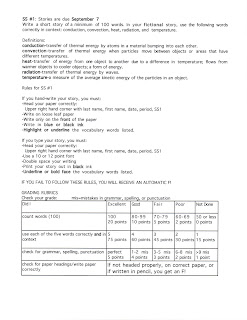
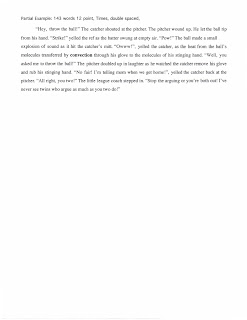
Follow all directions carefully!
Students will be able to:
use information from texts, supplementary texts, inquiry activities and classroom discussions to
-identify, compare, and contrast temperature, heat and thermal energy.
-design an experiment to model conduction, convection, and radiation.
Students took a quiz covering materials covered in class so far, which include the scientific process and heat transfer.
Students received instructions for writing short story one, which is due on Tuesday. The instructions and rubrics can be found at the top of this blog.
Students reviewed the concepts of heat and temperature via BrainPops so they would have information to plan their group experiments.
Students updated their interactive notebooks. By now, notebooks should include:
The Scientific Process notes, questions and summaries, cartoon.
Heat Transfer notes, questions, summaries, home learning 1, cartoon.
Heat and Temperature, notes, questions, summaries, home learnings 2 and 3.
Remember, your short story is due on Tuesday!
Thursday, September 2, 2010
Thursday, 2 September, 2010
Students will be able to:
use information from texts, supplementary texts, inquiry activities and classroom discussions to
-identify, compare, and contrast temperature, heat and thermal energy.
-design an experiment to model conduction, convection, and radiation.
The do now was to construct a concept map using the following terms:
heat energy, heat transfer, temperature, thermometer, conduction, convection, radiation, Fahrenheit, and Celsius.
Students turned in and reviewed home learning 3.
Students updated the interactive notebook, including writing leveled questions and the summary. They also pasted in all handouts.
use information from texts, supplementary texts, inquiry activities and classroom discussions to
-identify, compare, and contrast temperature, heat and thermal energy.
-design an experiment to model conduction, convection, and radiation.
The do now was to construct a concept map using the following terms:
heat energy, heat transfer, temperature, thermometer, conduction, convection, radiation, Fahrenheit, and Celsius.
Students turned in and reviewed home learning 3.
Students updated the interactive notebook, including writing leveled questions and the summary. They also pasted in all handouts.
Wednesday, September 1, 2010
Wednesday, 1 September, 2010

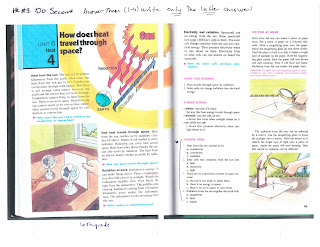
Please follow all written directions when you do these home learning questions!
Students will be able to:
use information from texts, supplementary texts, inquiry activities and classroom discussions to
-identify, compare, and contrast temperature, heat and thermal energy.
-design an experiment to model conduction, convection, and radiation.
The do now was to draw pictures that represent conduction, convection/and radiation.
Students received home learning 3, which can be found at the top of this blog. Be sure to place both on the same sheet of properly headed loose leaf paper. For the first sheet, write true if the statement as written is true. If the statement is false, look at the underlined word. Write the word on your paper that would make the statement true. For the second sheet, write only the letter answer. Remember, your home learning should be on loose leaf paper, written in blue or black ink or pencil.
Students saw heat transfer in action as they watched a "dancing penny" demonstration.
Groups completed their presentations on condensation, convection, and radiation.
Conduction is the transfer of thermal energy through a material by atoms in the material bumping into each other. When you put a cold spoon into a warm cup of tea, the part of the spoon in the hot tea becomes warmer. The atoms and molecules move
faster. These particles hit other slower-moving particles in the spoon. Thermal energy transfers from the faster-moving particles to the slower-moving particles farther up the spoon’s handle.
Convection transfers thermal energy when particles move between objects or areas that have different temperatures. Convection is most common in liquids and gases. As temperature increases, particles move faster and spread farther apart. So the density of the material decreases. The warmer, less dense material rises and the colder, denser material sinks. An example of convection can be found when you look at the flow of air in a two story house. The hot, less dense air rises to the top floor, while the cooler, more dense air can be found on the first floor.
Radiation is the transfer of thermal energy by waves. When waves hit an object, the object absorbs their energy and its temperature rises. Earth gets energy from the Sun through radiation. A microwave oven uses microwave radiation to transfer energy to the food.
Students will paste in all handouts and home learnings at the next class meeting, as well as write their three quality questions and lesson summary.
Subscribe to:
Posts (Atom)

